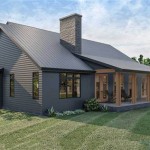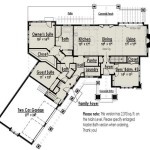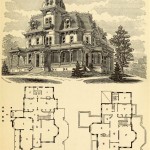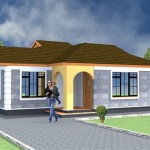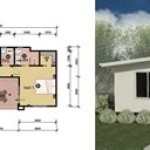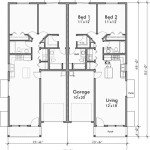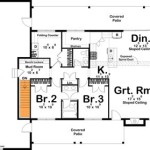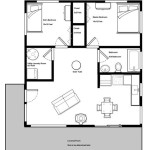Single Slope Roof House Plans: Design, Benefits, and Considerations
Single slope roof house plans, also known as shed roof designs, are characterized by a roof that slopes in only one direction. This architectural style is increasingly popular due to its modern aesthetic, cost-effectiveness, and environmental benefits. These designs offer a unique approach to residential construction, providing opportunities for creative architectural expression and enhanced functionality.
The simplicity of a single slope roof contrasts with traditional gable or hip roofs, offering a clean and contemporary look. This simplicity often translates to lower construction costs, as the design requires fewer materials and less complex labor. Furthermore, the configuration of a single slope roof allows for excellent water runoff management and potential for solar panel integration.
The selection of a single slope roof house plan involves careful consideration of several factors, including the desired aesthetic, climate conditions, building codes, and budget. A thorough understanding of these aspects is crucial for a successful and satisfactory build.
Advantages of Single Slope Roof Designs
Single slope roofs present several key advantages compared to more traditional roof designs. These advantages range from cost savings and ease of construction to environmental benefits and design flexibility.
Cost-Effectiveness: The simplicity of the single slope roof design translates to reduced material costs and simplified labor requirements. Less material is needed compared to more complex roof structures, and the straightforward construction process reduces labor time and associated expenses. The reduced complexity can also lead to faster construction timelines, further contributing to cost savings.
Modern Aesthetic: Single slope roofs offer a clean, minimalist aesthetic that is highly sought after in contemporary architecture. The sharp lines and simple geometry contribute to a modern and sophisticated look. This design element can be easily integrated into a variety of architectural styles, complementing both urban and rural settings.
Water Management: The single sloping surface ensures efficient water runoff. This is particularly beneficial in regions with heavy rainfall or snowfall, as it minimizes the risk of water accumulation and potential damage to the roof structure. The focused water runoff can also be directed towards specific drainage systems, preventing water from pooling around the foundation of the house.
Solar Panel Integration: The uniform slope of the roof is ideally suited for the installation of solar panels. The panels can be positioned at the optimal angle to maximize solar energy absorption, leading to greater energy efficiency and reduced electricity costs. The single plane allows for a seamless and aesthetically pleasing integration of solar technology.
Design Flexibility: While simple in its basic form, the single slope roof design offers considerable flexibility in terms of overall house design. It can be incorporated into a variety of floor plans and architectural styles. The pitch of the roof can be adjusted to create different visual effects and to accommodate varying ceiling heights inside the house.
Potential for Natural Light: Depending on the orientation of the slope, a single slope roof can be designed to maximize the amount of natural light entering the house. Large windows can be incorporated into the high side of the roof, providing ample daylight and reducing the need for artificial lighting. This can result in significant energy savings and a more comfortable living environment.
Factors to Consider When Choosing a Single Slope Roof Plan
Selecting a single slope roof plan requires careful consideration of several factors to ensure the design meets the specific needs and preferences of the homeowner, as well as complying with local building codes and environmental conditions.
Climate Conditions: The local climate plays a crucial role in determining the appropriate roof pitch and material selection. In areas with heavy snowfall, a steeper pitch is generally recommended to ensure efficient snow removal. In windy regions, the roof must be designed to withstand high winds and prevent uplift. The choice of roofing materials should also be appropriate for the climate, with durable and weather-resistant options being preferred.
Roof Pitch: The roof pitch, or angle of the slope, is a critical design element that affects both aesthetics and functionality. A steeper pitch provides better water runoff and snow shedding but may also increase the overall height of the house. A shallower pitch provides a more subtle look but may require more careful attention to waterproofing. The optimal roof pitch will depend on the climate, the desired aesthetic, and local building codes.
Orientation: The orientation of the roof slope should be carefully considered in relation to the sun's path. Orienting the slope towards the south or southwest can maximize solar gain in colder climates. However, in warmer climates, orienting the slope away from the sun can help reduce heat gain and lower cooling costs. The orientation should also take into account prevailing wind directions to minimize wind loads on the roof.
Drainage: Proper drainage is essential for a single slope roof to prevent water damage. The roof must be designed with an adequate gutter system to collect and direct water away from the house. The gutters should be properly sized to handle the expected volume of runoff and should be regularly maintained to prevent clogging. The drainage system should also be designed to prevent water from pooling around the foundation of the house.
Building Codes and Regulations: It is important to comply with all applicable building codes and regulations when designing and constructing a single slope roof. These codes may specify requirements for roof pitch, structural integrity, fire resistance, and insulation. It is advisable to consult with a qualified building professional to ensure that the design meets all applicable requirements.
Material Selection: The choice of roofing materials will impact the appearance, durability, and performance of the roof. Common roofing materials for single slope roofs include metal, asphalt shingles, and wood. Metal roofs are durable, fire-resistant, and can be recycled. Asphalt shingles are a more affordable option but may not last as long as metal. Wood roofs offer a natural aesthetic but require more maintenance. The material selection should be based on the climate, the desired aesthetic, and the budget.
Designing for Energy Efficiency with Single Slope Roofs
Single slope roofs can be designed to enhance energy efficiency, contributing to lower utility bills and a more sustainable living environment. Several strategies can be implemented to maximize the energy performance of a single slope roof house.
Insulation: Proper insulation is crucial for minimizing heat loss in the winter and heat gain in the summer. The roof should be insulated with a high R-value material to reduce energy transfer. Common insulation materials include fiberglass, cellulose, and spray foam. The thickness of the insulation should be determined based on the climate and local building codes. Proper ventilation should also be provided to prevent moisture buildup within the insulation.
Ventilation: Adequate ventilation is essential for preventing moisture buildup and maintaining a comfortable indoor temperature. Ventilation can be provided through vents located at the eaves and ridge of the roof. These vents allow for airflow that helps to remove excess moisture and heat. The amount of ventilation required will depend on the climate and the size of the roof.
Cool Roofing Materials: Cool roofing materials reflect more sunlight and absorb less heat than traditional roofing materials. This can significantly reduce the roof's surface temperature and lower cooling costs. Cool roofing materials are available in a variety of colors and styles, including reflective coatings and specially designed shingles.
Solar Orientation: As mentioned earlier, the orientation of the roof slope can be optimized to maximize solar gain or minimize heat gain. In colder climates, orienting the slope towards the south can increase solar heat gain in the winter, reducing the need for artificial heating. In warmer climates, orienting the slope away from the sun can reduce heat gain and lower cooling costs.
Green Roofs: A green roof, also known as a living roof, is a roof that is partially or completely covered with vegetation. Green roofs provide numerous environmental benefits, including improved insulation, reduced stormwater runoff, and increased biodiversity. They can also enhance the aesthetic appeal of the house and provide a tranquil outdoor space.
Skylights and Clerestory Windows: Skylights and clerestory windows can be incorporated into the roof to provide natural daylighting. This can reduce the need for artificial lighting and lower energy consumption. Skylights should be carefully selected to minimize heat gain in the summer and heat loss in the winter. Clerestory windows, which are typically located high on the wall, can provide indirect daylighting that is less prone to glare.
Single slope roof house plans offer a modern, cost-effective, and environmentally friendly approach to residential construction. By carefully considering the design, materials, and energy efficiency strategies, homeowners can create a comfortable, sustainable, and visually appealing living space.

Single Sloped Roofs Ramp Up Modern Homes

Slanted Single Pitch Shed Roof House Plans Floor

16 Examples Of Modern Houses With A Sloped Roof

Single Slope Roof Patio Roofs Shed Modern Design Contemporary Exterior House

Buy Single Roof House Plan Eplan

House Plans 8x6 With 2 Bedrooms Slope Roof Construction Plan Gable

Single Sloped Roofs Ramp Up Modern Homes

Single Slope Metal Building Worldwide Steel Buildings Projects

Modern And Cool Shed Roof House Plans Houseplans Blog Com

Affordable Home Plan Ch457 House

